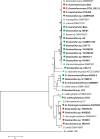Comparative analysis of the Geobacillus hemicellulose utilization locus reveals a highly variable target for improved hemicellulolysis
- PMID: 25273399
- PMCID: PMC4194401
- DOI: 10.1186/1471-2164-15-836
Comparative analysis of the Geobacillus hemicellulose utilization locus reveals a highly variable target for improved hemicellulolysis
Abstract
Background: Members of the thermophilic genus Geobacillus can grow at high temperatures and produce a battery of thermostable hemicellulose hydrolytic enzymes, making them ideal candidates for the bioconversion of biomass to value-added products. To date the molecular determinants for hemicellulose degradation and utilization have only been identified and partially characterized in one strain, namely Geobacillus stearothermophilus T-6, where they are clustered in a single genetic locus.
Results: Using the G. stearothermophilus T-6 hemicellulose utilization locus as genetic marker, orthologous hemicellulose utilization (HUS) loci were identified in the complete and partial genomes of 17/24 Geobacillus strains. These HUS loci are localized on a common genomic island. Comparative analyses of these loci revealed extensive variability among the Geobacillus hemicellulose utilization systems, with only seven out of 41-68 proteins encoded on these loci conserved among the HUS+ strains. This translates into extensive differences in the hydrolytic enzymes, transport systems and metabolic pathways employed by Geobacillus spp. to degrade and utilize hemicellulose polymers.
Conclusions: The genetic variability among the Geobacillus HUS loci implies that they have variable capacities to degrade hemicellulose polymers, or that they may degrade distinct polymers, as are found in different plant species and tissues. The data from this study can serve as a basis for the genetic engineering of a Geobacillus strain(s) with an improved capacity to degrade and utilize hemicellulose.
Figures




Similar articles
-
The genus Geobacillus and their biotechnological potential.Adv Appl Microbiol. 2015;92:1-48. doi: 10.1016/bs.aambs.2015.03.001. Epub 2015 May 5. Adv Appl Microbiol. 2015. PMID: 26003932 Review.
-
Comparative genomic analysis of the flagellin glycosylation island of the Gram-positive thermophile Geobacillus.BMC Genomics. 2016 Nov 14;17(1):913. doi: 10.1186/s12864-016-3273-2. BMC Genomics. 2016. PMID: 27842516 Free PMC article.
-
Complete Genome Sequence of Geobacillus thermodenitrificans T12, A Potential Host for Biotechnological Applications.Curr Microbiol. 2018 Jan;75(1):49-56. doi: 10.1007/s00284-017-1349-0. Epub 2017 Sep 12. Curr Microbiol. 2018. PMID: 28900693 Free PMC article.
-
Genomic mining of Geobacillus stearothermophilus GF16 for xylose production from hemicellulose-rich biomasses using secreted enzymes.N Biotechnol. 2024 Sep 25;82:14-24. doi: 10.1016/j.nbt.2024.04.002. Epub 2024 Apr 28. N Biotechnol. 2024. PMID: 38688408
-
Genetic engineering of Geobacillus spp.J Microbiol Methods. 2015 Apr;111:31-9. doi: 10.1016/j.mimet.2015.02.002. Epub 2015 Feb 3. J Microbiol Methods. 2015. PMID: 25659824 Review.
Cited by
-
Comparative genomic analysis of Parageobacillus thermoglucosidasius strains with distinct hydrogenogenic capacities.BMC Genomics. 2018 Dec 6;19(1):880. doi: 10.1186/s12864-018-5302-9. BMC Genomics. 2018. PMID: 30522433 Free PMC article.
-
The Geobacillus Pan-Genome: Implications for the Evolution of the Genus.Front Microbiol. 2016 May 24;7:723. doi: 10.3389/fmicb.2016.00723. eCollection 2016. Front Microbiol. 2016. PMID: 27252683 Free PMC article.
-
Pan-Genome Analyses of Geobacillus spp. Reveal Genetic Characteristics and Composting Potential.Int J Mol Sci. 2020 May 11;21(9):3393. doi: 10.3390/ijms21093393. Int J Mol Sci. 2020. PMID: 32403359 Free PMC article.
-
In vivo selection of sfGFP variants with improved and reliable functionality in industrially important thermophilic bacteria.Biotechnol Biofuels. 2018 Jan 17;11:8. doi: 10.1186/s13068-017-1008-5. eCollection 2018. Biotechnol Biofuels. 2018. PMID: 29371884 Free PMC article.
-
Carbon Monoxide Induced Metabolic Shift in the Carboxydotrophic Parageobacillus thermoglucosidasius DSM 6285.Microorganisms. 2021 May 19;9(5):1090. doi: 10.3390/microorganisms9051090. Microorganisms. 2021. PMID: 34069472 Free PMC article.
References
-
- Ebringerova AZH, Heinze T. Hemicellulose. Adv Polymer Sci. 2005;185:1–67. doi: 10.1007/b136816. - DOI
Publication types
MeSH terms
Substances
LinkOut - more resources
Full Text Sources
Other Literature Sources
Miscellaneous

